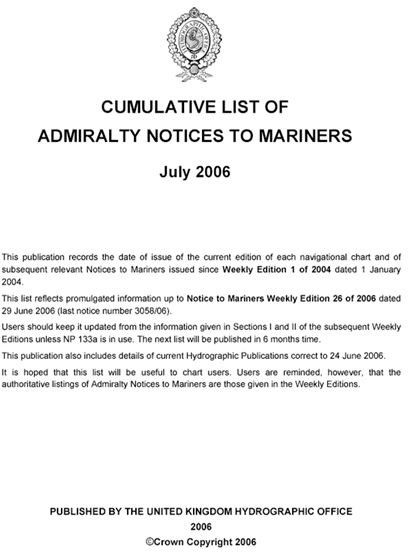Marine navigation charts and use of notices to mariners
The contents of Notices to Mariners (NMs )
We studied about the concept of Marine Navigation Charts, and the correction of charts used on ships in our previous articles. The weekly Notices to Mariners contain, amongst other information, individual notices (not to be confused with the NM itself). A NM is broken up into the following sections:
• Section I – Explanatory Notes and list of Publications
• Section II – Geographical Index
Index of Affected Charts: matches chart numbers affected with notice
Corrections to Charts: individual notices to be used in chart correction.
Temporary and Preliminary notices in force at time of publication of NM
• Section III – Reprints of Navigational Warnings (in force)
• Section IV – Amendments to Admiralty Sailing Directions (not for charts)
• Section V – Amendments to Admiralty List of Lights (not for charts)
• Section VI – Amendments to Admiralty list of Radio Signals (not for charts)
Sections IV through VI are used for correcting other Admiralty publications in use on board and not charts. Some of these publications are the List of Lights and fog signals, Sailing Directions, Admiralty list of Radio Signals etc. There are hundreds of such publications on board, depending on the trade of the ship and the voyages she is likely to make.
The procedure for navigational chart correction
As said earlier, this is systematic and follows the following sequence- the sequence is very important for accuracy.
Large corrections
- Check the Charts carried on board against the Index of Affected Charts in the NM
- Check which notices affect charts on board, and find the Notice in section II
- Note that, at the bottom of each notice is a list of all charts affected by it, as well as the previous notice which affected that chart. This previous notice may be sometimes years old, but this information assists in confirming that the last correction(s) have been made on the chart in question.
- Check that the previous notice has been applied to the chart (each chart has, at its bottom left, a list of corrections written on it by whoever corrected the chart. This information is also available in a separate Chart correction log that is maintained on board)
- If any charts have not been updated, they must be corrected to the previous notice before the current notice is applied.
- Tracings are used to correct charts, when available.
- Corrections are made in indelible ink, ensuring that standard symbols are used, that the correction is made neatly and accurately and does not obscure other information on the chart.
- After correction, an entry is made on the bottom left of the chart as well as the chart correction log, as indicated earlier
Small corrections
As explained in the first article on chart correction, these mainly consist of Temp and Preliminary Notices (also called T and P notices) and Navigational warnings (nav warnings)
The procedure for small corrections is as follows
- Sections III and IV (See above) are detached from the NM and file. These give a list of T and P notices and Nav warnings still in force.
- Charts on board and in use in the present voyage are corrected for these notices. The correction is made in pencil, as explained in the last article. This is because these notices are transient and will change or vanish. (information available in same sections III and IV of subsequent NMs)
- While on the passage, other T, P notices and Nav Warnings may be received on Navtex, VHF etc (see previous article). Charts in use will be corrected for these as the information comes in.
Cumulative Notices to Mariners

To assist mariners in chart correction, the British Admiralty started publishing these in addition to the weekly NMs a couple of decades ago. The salient features of the Cumulative NMs are as follows:
• Published biannually, Jan and June
• Contains the numbers of all Notices affecting all the charts that exist for the last 2 years
• Latest edition dates of each chart are marked.
The mariner can then, at a quick glance, check that
- He has the latest edition of each chart on board (new editions of charts are published regularly, just like books. When this happens, the older editions are defunct and must be replaced)
- Since he can read off the notices affecting each chart for the last two years, he can confirm that all corrections on board have been made and marked on either the chart itself, or in the separate chart correction log.
- Note that the Cumulative NM does not give any details of the small corrections like T/P notices and Nav warnings.
Conclusion
As can be seen, chart correction is a tedious but essential exercise. Done systematically, it ensures that a mariner is always using a chart that has the most current information on it- an essential ingredient of safety.
It may be noted that all British Admiralty publications on board- and there are scores of them- are also corrected in a similar manner, through the use of Notices to Mariners.
This post is part of the series: An overview of marine navigational charts and their correction at sea.
Charts at sea: how they are made and how they are kept current.
